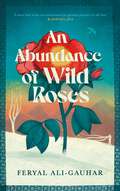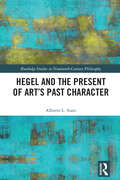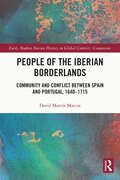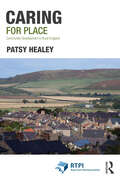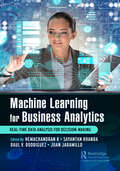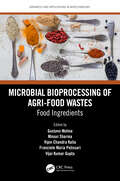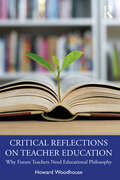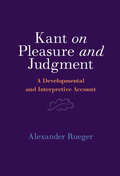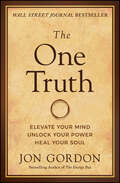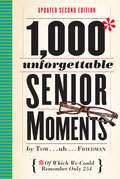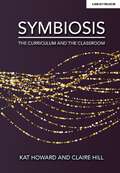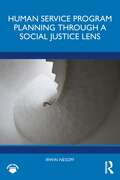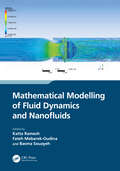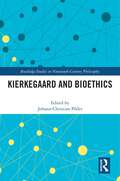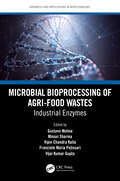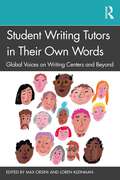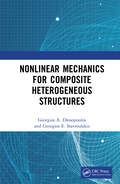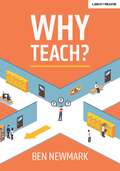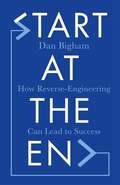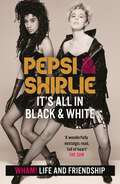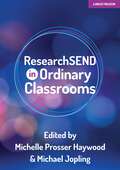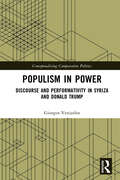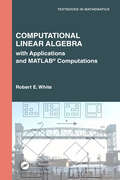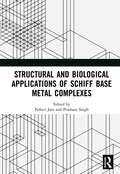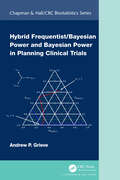- Table View
- List View
An Abundance of Wild Roses
by Feryal Ali-GauharIn the Black Mountains of Pakistan, the discovery of an unconscious, unknown man is the first snowball in an avalanche of chaos. The head of the village is beset with problems – including the injured stranger – and failing to find his way out. His daughter receives a love letter and incurs her father’s wrath. A lame boy foretells disaster, but nobody is listening. Trapped in terrible danger, a wolf-dog is battling ice and death to save a soldier’s life. Beaten by her addict husband for bearing him only daughters, a woman is pregnant again – but can this child save her? As the elements turn on the village, can humanity find a way to co-exist with nature that doesn’t destroy either of them?
Hegel and the Present of Art’s Past Character (Routledge Studies in Nineteenth-Century Philosophy)
by Alberto L. SianiThis book reclaims Hegel’s notion of the “end of art”—or, more precisely, of “art’s past character”—not just as a piece of the history of philosophy but as a living critical and interpretive methodology. It addresses the presence of the past character of art in both Hegel and contemporary philosophy and aesthetics. The book’s innovative contribution lies in unifying the Hegelian thesis with discussions of contemporary art and philosophy. The author not only offers a Hegelian exegesis but also applies the idea of the past character of art to themes that are related to both Hegel’s philosophy, such as the French Revolution and the modern state, Kantian aesthetics, and religion and the sacred space disclosed for art, and going beyond Hegel, such as Celan's poetry, Gramsci's criticism of Croce, human rights, and even the grunge rock band Pearl Jam. Conversely, such non-Hegelian explorations will help enlighten what may look like a specific thread of Hegel’s aesthetics, but can be used to shed light on some core motives of his philosophy. The author’s interpretation of art’s past character reclaims the full value, attractiveness, and philosophical soundness of Hegel’s thesis, while rejecting its interpretation in terms of a complete dissolution of the aesthetic element into the philosophical one. Hegel and the Present of Art’s Past Character will be of interest to scholars and advanced students working on Hegel, philosophy of art and aesthetics, history of philosophy, political philosophy, and art theory.
People of the Iberian Borderlands: Community and Conflict between Spain and Portugal, 1640–1715 (Early Modern Iberian History in Global Contexts)
by David Martín MarcosThis book is devoted to the inhabitants of the Spanish–Portuguese borderlands during the early modern period. It seeks to challenge a predominant historiography focused on the study of borderlands societies, relying exclusively on the antagonistic topics of subversion and the construction of boundaries. It states that by focusing just on one concept or another there is a restrictive understanding tending to condition the agency of local communities by external narratives. Thus, if traditionally border people were reduced by some scholars to actors of a struggle against a supposedly imposed border; in a more modern perspective, their behaviors have been also framed in bottom-up processes of consolidation of spaces of sovereignty in a no less limiting vision. Faced with both approaches, the objective of this work is not to deny them but, first and foremost, to situate the experiences of border populations outside of logics that I understand as originally alien to themselves, and to highlight their own subjectivity. Finally, it also demonstrates that most of the practices developed by border people were fundamentally aimed at defending their local communities.It will be useful for both audiences interested in early modern Iberia or border studies from a bottom-up perspective.
Caring for Place: Community Development in Rural England (ISSN)
by Patsy HealeyThis book draws on preeminent planning theorist Patsy Healey’s personal experiences as a resident of a small rural town in England, to explore what place and community mean in a particular context, and how different initiatives struggle to get a stake in the wider governance relations while maintaining their own focus and ways of working. Throughout the book, Healey assesses the public value generated by community initiatives and the impact of such activity on wider governance dynamics.Healey explores the power which small communities are able to mobilise through self-organisation and grassroots activism. Through the lens of Wooler and Glendale as a micro-society, the book centres on a community experiencing an economic and demographic transition. It focuses on three initiatives developed and led by local people – a small community development trust, an informal attentionmobilising network, and a Neighbourhood Plan project which uses an opportunity provided within the formal planning system. It examines how, in such civil society activism, people came together to promote local development in a place and community neglected by the dominant political economy.The book details the power and force of community initiative and its potential for transforming both the future possibilities for the place and community itself, as well as wider governance relations. Overall, it seeks to enrich academic and policy discussion about how the relations between formal government and civil society energy could evolve in more productive and progressive directions.
Machine Learning for Business Analytics: Real-Time Data Analysis for Decision-Making
by Hemachandran K. Sayantan Khanra Raul V. Rodriguez Juan R. JaramilloMachine Learning is an integral tool in a business analyst’s arsenal because the rate at which data is being generated from different sources is increasing and working on complex unstructured data is becoming inevitable. Data collection, data cleaning, and data mining are rapidly becoming more difficult to analyze than just importing information from a primary or secondary source. The machine learning model plays a crucial role in predicting the future performance and results of a company. In real-time, data collection and data wrangling are the important steps in deploying the models. Analytics is a tool for visualizing and steering data and statistics. Business analysts can work with different datasets -- choosing an appropriate machine learning model results in accurate analyzing, forecasting the future, and making informed decisions. The global machine learning market was valued at $1.58 billion in 2017 and is expected to reach $20.83 billion in 2024 -- growing at a CAGR of 44.06% between 2017 and 2024. The authors have compiled important knowledge on machine learning real-time applications in business analytics. This book enables readers to get broad knowledge in the field of machine learning models and to carry out their future research work. The future trends of machine learning for business analytics are explained with real case studies. Essentially, this book acts as a guide to all business analysts. The authors blend the basics of data analytics and machine learning and extend its application to business analytics. This book acts as a superb introduction and covers the applications and implications of machine learning. The authors provide first-hand experience of the applications of machine learning for business analytics in the section on real-time analysis. Case studies put the theory into practice so that you may receive hands-on experience with machine learning and data analytics. This book is a valuable source for practitioners, industrialists, technologists, and researchers.
Microbial Bioprocessing of Agri-food Wastes: Food Ingredients (Advances and Applications in Biotechnology)
by Gustavo Molina Minaxi Sharma Vipin Chandra Kalia Franciele Maria Pelissari Vijai Kumar GuptaFood ingredients are important molecules of the most diverse chemical classes responsible for conferring nutrition, stability, color, flavor, rheological and sensorial characteristics, in addition to several other important uses in the food industry. In this way, the production routes of these ingredients have gained more and more attention from consumers and producing industries, who expect that, in addition to their technological properties, these ingredients are still obtained without synthetic means, with savings of natural resources and mainly with less environmental impact. This book is intended for bioengineers, biologists, biochemists, biotechnologists, microbiologists, food technologists, enzymologists, and related professionals/ researchers. • Explores recent advances in the valorization of agri-food waste into food ingredients • Provides technical concepts on the production of various food ingredients of commercial interest• Explores novel technologically advanced strategies for the extraction of bioactive compounds from food wastes• Presents important classes of food ingredients obtained from alternative raw materials• Presents sustainable food waste resources and management strategies• Presents different pretreatment technologies and green extraction methodologies to support a green environment in the circular economy concept.• Challenges in applications of re-derived bioactive compounds from food wastes in food formulations
Critical Reflections on Teacher Education: Why Future Teachers Need Educational Philosophy
by Howard WoodhouseCritical Reflections on Teacher Education argues that educational philosophy can improve the quality of teacher education programs in Canada, the United States, and the United Kingdom. The book documents the ways in which the market model of education propagated by governments and outside agencies hastens the decline of philosophy of education and turns teachers into technicians in hierarchical school systems. A grounding in educational philosophy, however, enables future teachers to make informed and qualified judgements defining their professional lives. In a clear and accessible style, Howard Woodhouse uses a combination of reasoned argument and narrative to show that educational philosophy, together with Indigenous knowledge systems, forms the basis of a climate change education capable of educating future teachers and their students about the central issue of our time.
Kant on Pleasure and Judgment: A Developmental and Interpretive Account
by null Alexander RuegerWere there interactions between the development of Kant's aesthetics and the development of his moral philosophy? How did Kant view pleasure and displeasure and what role did they play in the formation of his system of the faculties? In this book, Alexander Rueger situates Kant's account of pleasure and displeasure in its eighteenth-century context, with special attention to Leibniz, Wolff, Crusius, and Mendelssohn. He traces the development of Kant's views on pleasure from the 1770s to his Critique of Aesthetic Judgment in 1790, and shows that throughout, Kant understood pleasure as the satisfaction of faculty interests. The significance of this theory for the completion of Kant's critical system in the third Critique is discussed in detail. Rueger's study illuminates both the role of pleasure and displeasure in Kant's thought, and their important connections to the power of judgment.
The One Truth: Elevate Your Mind, Unlock Your Power, Heal Your Soul (Jon Gordon)
by Jon GordonWall Street Journal BestsellerThe One Truth is the One Thing that Explains Everything The One Truth, by 14x best-selling author and thought leader Jon Gordon, guides you on a path to discover revolutionary insights, ancient truths and practical strategies to elevate your mind, unlock your power and live life to the fullest. The One Truth is that our state of mind, the thoughts we think, the words we say, the life we live, the power we have and everything we experience is ultimately influenced by oneness and separateness. As you learn about the unseen forces that lower your state of mind, separate and weaken you and the hidden power that elevates your mind, unites and strengthens you, you’ll see life through a new lens, think with more clarity, confidence and act at higher level. Once you know the One Truth, you’ll see how it impacts leadership, teamwork, mindset, performance, relationships, addictions, social media, anxiety, mental health, healing and ultimately determines what you create and experience. For example, a team that is divided is disconnected and powerless. A team that is united is connected and powerful. The same applies to you. When you feel a sense of oneness, connection, and unity you feel strong. When you feel separate, you feel disconnected and weak. The truth is, we are not meant to go through life feeling anxious, disconnected, insecure, cluttered, chronically stressed, worried and sad most of the time. We are meant to heal the hole in our soul and become whole. We are meant to live with hope, clarity, power, purpose, and confidence. The One Truth will show you how!
1,000 Unforgettable Senior Moments: Of Which We Could Remember Only 254
by Tom FriedmanThe president who left the nuclear launch codes in a suit at the dry cleaners. The novelist who put the orange juice outside and the kitten in the refrigerator. The Russian general who left home in full military dress . . . minus his pants. The famous sex goddess who blew the same line through 52 takes. And the rock star who no longer remembers 1975. Filled with classic lapses, gaffes, and mental bloopers, 1,000 Unforgettable Senior Moments is a fabulous and witty gift for anyone of a certain age. And now it is updated, revised with more than 20 percent new stories, and repackaged in two color, making it an even more vibrant, visually appealing, fresh, and compellingly readable book. Anyone who&’s ever had a mental lapse will empathize with relative spring chicken Nicki Minaj, who, while accepting a BET Viewers&’ Choice Award, forgot why she was receiving the statuette (on live national television, no less). Or the team of astrophysicists who believed they had discovered proof of alien life—only to discover the signals were coming from the lunchroom microwave. Here&’s a best man forgetting to show up at the wedding, a musician leaving his priceless cello in a cab, the bank robber who wrote a holdup note on a paycheck stub that had his name and address printed on it, and the Fox studio chief who, when pressed by his leading lady to remember her name, offered &“. . . Cleopatra?&”
Symbiosis: The Curriculum and the Classroom
by Claire Hill Kat HowardHas our system of accountability and quick fixes meant we've lost perspective of what can really improve the quality of education? With a multitude of issues at the heart of some of our more toxic schools, including micro-management, over-complicated policy and the intricate measurement of the wrong foci, it appears that teachers are experiencing a disconnect from the very reason they joined teaching in the first place. With little autonomy over what's important, fewer teachers enter the profession than the monumental amount of teachers that are leaving, and those that do, do so with reluctance and regret. With an astute examination of practice in schools, Claire Hill and Kat Howard take a thoughtful and strategic view of how to ensure a sense of connection and cohesion within schools, to ensure that all feel part of the collective curricular journey towards a gold standard. With a consideration of research-informed practice, this book will provide a series of strategies for curriculum designers at every level, keeping the high quality teachers that we very much need in schools, and providing a better palette to students in the process. At a time where teaching is somewhat politicised, monetised and overcomplicated, Symbiosis: Curriculum and the Classroom sets about the task of refining the way in which we run our schools to improve the quality of our everyday lives in schools.
Human Service Program Planning Through a Social Justice Lens
by Irwin NesoffHuman Service Program Planning Through a Social Justice Lens provides a foundation in social justice to students while developing practical skills and knowledge about the steps and tasks involved in planning social programs.Through the "parallel process" of contextualizing social issues while teaching the process of program planning, students will develop a perspective on the need for social justice planning and its impact on marginalized communities and populations. The textbook explores current concepts and approaches to understanding social issues and involving impacted communities and individuals. These include: Intersectionality, Appreciative Inquiry, Participatory Planning and Visioning, which serve to challenge preconceptions while coupling these with the step-by-step approach to planning using the Logic Model.Utilizing meaningful examples to demonstrate how social justice planning can be implemented, Human Service Program Planning Through a Social Justice Lens is appropriate for students of social work as well as practitioners in human services, public administration and public health.
Mathematical Modelling of Fluid Dynamics and Nanofluids
by Katta Ramesh Fateh Mebarek-Oudina Basma SouayehMathematical Modelling of Fluid Dynamics and Nanofluids serves as a comprehensive resource for various aspects of fluid dynamics simulations, nanofluid preparation, and numerical techniques.The book examines the practical implications and real-world applications of various concepts, including nanofluids, magnetohydrodynamics, heat and mass transfer, and radiation. By encompassing these diverse domains, it offers readers a broad perspective on the interconnectedness of these fields.The primary audience for this book includes researchers and graduate students who possess a keen interest in interdisciplinary studies within the realms of fluid dynamics, nanofluids, and biofluids. Its content caters to those who wish to deepen their knowledge and tackle complex problems at the intersection of these disciplines.
Kierkegaard and Bioethics (Routledge Studies in Nineteenth-Century Philosophy)
by Johann-Christian PõderThis book explores Kierkegaard’s significance for bioethics and discusses how Kierkegaard’s existential thinking can enrich and advance current bioethical debates.A bioethics inspired by Kierkegaard is not focused primarily on ethical codes, principles, or cases, but on the existential 'how' of our medical situation. Such a perspective focuses on the formative ethical experiences that an individual can have in relation to oneself and others when dealing with medical decisions, interventions, and information. The chapters in this volume explore questions like: What happens when medicine and bioethics meet Kierkegaard? How might Kierkegaard’s writings and thoughts contribute to contemporary issues in medicine? Do we need an existential turn in bioethics? They offer theoretical reflections on how Kierkegaard’s existential thinking might contribute to bioethics and apply Kierkegaardian concepts to debates on health and disease, predictive medicine and enhancement, mental illness and trauma, COVID-19, and gender identity.Kierkegaard and Bioethics will be of interest to scholars and advanced students working on Kierkegaard, bioethics, moral philosophy, existential ethics, religious ethics, and the medical humanities.
Microbial Bioprocessing of Agri-food Wastes: Industrial Enzymes (Advances and Applications in Biotechnology)
by Gustavo Molina Minaxi Sharma Vipin Chandra Kalia Franciele Maria Pelissari Vijai Kumar GuptaEnzymes are biological molecules of great relevance. In addition to the fundamental role in metabolic reactions, they have diverse applications in industrial processes in generating products of great commercial utility for the most diverse areas. Thus, industries seek to expand research to select microorganisms capable of producing enzymes according to their commercial objectives. Considering the diversity of the microbiota kingdom, as well as the diversity of mode of action of different classes of enzymes, this is an area that deserves constant investments to elucidate new applications, considering that these biological catalysts have great selectivity and a diversity of mode of action, reusable, and operate under mild process conditions, becoming the bridge for the development of sustainable processes and for adding value to commercial products. This book is intended for bioengineers, biologists, biochemists, biotechnologists, microbiologists, food technologists, enzymologists, and related professionals/ researchers.• Explores recent advances in the valorization of agri-food waste into enzymes • Explores the main technological advances in the recovery of residues and their use for the production of enzymes• Provides technical concepts on the production of various enzymes of commercial interest • Presents the main classes of enzymes obtained from alternative raw materials.
Student Writing Tutors in Their Own Words: Global Voices on Writing Centers and Beyond
by Max OrsiniStudent Writing Tutors in Their Own Words collects personal narratives from writing tutors around the world, providing tutors, faculty, and writing center professionals with a diverse and experience-based understanding of the writing support process.Filling a major gap in the research on writing center theory, first-year writing pedagogy, and higher education academic support resources, this book provides narrative evidence of students' own experiences with learning assistance discourse communities. It features a variety of voices that address how academic support resources such as writing centers have served as the nucleus for students' (i.e., both tutors and their clients) sense of community and self, ultimately providing a space for freedom of discourse and expression. It includes narratives from writing tutors supporting students in unconventional spaces such as prisons, tutors offering support in war-torn countries, and students in international centers facing challenges of distance learning, access, and language barriers. The essays in this collection reveal pedagogical takeaways and insights about both student and tutor collaborative experiences in writing center spaces.These essays are a valuable resource for student writing tutors and anyone involved with them, including composition instructors and scholars, writing center professionals, and any faculty or administrators involved with academic support programs.
Nonlinear Mechanics for Composite Heterogeneous Structures
by Georgios A. Drosopoulos Georgios E. StavroulakisNonlinear Mechanics for Composite Heterogeneous Structures applies both classical and multi-scale finite element analysis to the non-linear, failure response of composite structures. These traditional and modern computational approaches are holistically presented, providing insight into a range of non-linear structural analysis problems. The classical methods include geometric and material non-linearity, plasticity, damage and contact mechanics. The cutting-edge formulations include cohesive zone models, the Extended Finite Element Method (XFEM), multi-scale computational homogenization, localization of damage, neural networks and data-driven techniques. This presentation is simple but efficient, enabling the reader to understand, select and apply appropriate methods through programming code or commercial finite element software. The book is suitable for undergraduate studies as a final year textbook and for MSc and PhD studies in structural, mechanical, aerospace engineering and material science, among others. Professionals in these fields will also be strongly benefited. An accompanying website provides MATLAB codes for two-dimensional finite element problems with contact, multi-scale (FE2) and non-linear XFEM analysis, data-driven and machine learning simulations.
Why Teach?
by Ben NewmarkAt the start of his career, Ben Newmark assumed that all the things he was told to do, from how to teach to how to record the progress of my pupils, were well planned and necessary. Sometimes things didn't feel right and seemed bizarre but, for the first couple of years of his career, he assumed this was because he was not skilled, knowledgeable or experienced enough to understand the rationale. But he couldn't keep this up forever. So he began to ask questions. And then he asked more. And the more he learned the more confused he became. To his horror it became clear that there wasn't a masterplan. Instead, education was a world full of contradictory thinking, bad planning and unintended consequences. Each chapter of this book tries to answer one of the questions he struggled with, trying to explain the reasons for the oddness and then give some advice on how schools and individual teachers might manage it. And it is possible to do better than manage it. For all its frustrating weirdness there isn't another job in the world he'd rather do. When finally he has to retire, he will be begging his closest school to teach two or three classes a week. Including chapters such as: Why are there so many spreadsheets in schools?; Why doesn't my school behaviour system work?; Why is teaching making me so unhealthy?; and Why won't my pupils work hard?
Start at the End: How Reverse-Engineering Can Lead to Success
by Dan BighamAn inspiring and thought-provoking new book that explains the power of applying reverse-engineering to all areas of your life, from a cycling champion who has proven its success. Dan Bigham is the captain of an amateur British track cycling team who rose from obscurity to beat professional, multi-million-pound teams at the highest level. Alongside hard work and dedication, Dan credits his success to one thing: reverse-engineering the result.In Start at the End, Dan uses his own story as well as wider examples and case studies from the worlds of business, personal development and other sports to demonstrate how this approach can help you succeed in any walk of life. Following each stage of the process, from setting goals and assessing your tools to developing the plan and delivering optimum performance, this book will fully explain how to set out and enact the system.A revolutionary new look at a powerful age-old wisdom, Start at the End is a fascinating exploration of how we can achieve success and proof that no goal is impossible.***'Start at the End isn't just a great story, but a really nice reminder of how to approach performance forensically, intelligently and purposefully – and that these lessons don't just belong in cycling but in all areas of high performance' Dr Josie Perry'Phenomenal ... Absolutely fascinating ... Incredible stuff, really clever' Stephen Dixon, Sky News
Pepsi & Shirlie - It's All in Black and White: Wham! Life and Friendship
by Pepsi Demacque-Crockett Shirlie KempLondon. Wham! Pop, glitz and glamour. And two girls with stars in their eyes.Our friendship began one windy day in 1982, outside Finsbury Park tube. It was an instant like at first sight. We were on our way to a Wham! rehearsal. Pepsi was the new girl in the band and over a car stereo, a cassette tape and that journey to Bushey we bonded. We had no idea that we were on the first of many journeys together and that soon we'd be travelling all over Europe, Australia, America, China and Japan. Or that no matter where we went, together, we'd find a way to make every exotic destination feel like home.We'd both been teenagers during the seventies – a dreary and difficult decade, especially if you were young in London and you didn't have much money.So, in 1982, anything was possible for us – a pair of twentysomethings who hadn't been to university, who didn't have any money, who dreamt of singing and dancing, but ultimately lived for fun. Everything felt new and life was a question mark. We had no idea what was lying ahead, but we wanted to say yes.What we didn't know was that we were saying yes to a lifetime of connection that has endured whatever we've done, wherever we've been. From the side of the stage to its centre – we have many stories to tell.And it's all here, it's all in black and white.
researchSEND in Ordinary Classrooms
by Michael Jopling Michelle Prosser HaywoodResearchSEND was developed to promote the importance of research in meeting the needs of learners with SEND through events, collaborations, publications and research projects. Here, Michelle Haywood edits a collection of short essays spanning the latest SEND-related research and detailing how practice can be enhanced by that research. Each chapter ends with accessible bullet points on how the research can be integrated into the classroom.
Populism in Power: Discourse and Performativity in SYRIZA and Donald Trump (Conceptualising Comparative Politics)
by Giorgos VenizelosShifting attention away from policy achievements and effects on democracy, this book focuses on the charismatic function of populist discourse – comprising antagonistic narratives, transgressive style and appeals to the common people.The book puts forward an integrative approach that brings together discourse analysis, analysis of digital media, in-depth interviews and ethnographic methods, and places into comparative perspective the cases of SYRIZA in Greece and Donald Trump in the United States. Theorising populism through the lens of collective identification, Venizelos places the rhetorical and emotional dynamics of populist performativity at the core of the analysis, offering a rigorous yet flexible conceptulisation of populism in power. Against theoretical expectations, findings suggest that both SYRIZA and Trump retained, to different degrees, their populist character in power, although their style and vision differed vastly.This book urges researchers, journalists and politicians to adopt a reflexive approach to analysing the political implications of populism for politics, polity and society, and to challenge the normatively charged definitions that are uncritically reproduced in the public sphere. It will appeal to researchers of political theory, populism, comparative politics, sociologists and ethnographers.
Computational Linear Algebra: with Applications and MATLAB® Computations (Textbooks in Mathematics)
by Robert E. WhiteCourses on linear algebra and numerical analysis need each other. Often NA courses have some linear algebra topics, and LA courses mention some topics from numerical analysis/scientific computing. This text merges these two areas into one introductory undergraduate course. It assumes students have had multivariable calculus. A second goal of this text is to demonstrate the intimate relationship of linear algebra to applications/computations.A rigorous presentation has been maintained. A third reason for writing this text is to present, in the first half of the course, the very important topic on singular value decomposition, SVD. This is done by first restricting consideration to real matrices and vector spaces. The general inner product vector spaces are considered starting in the middle of the text.The text has a number of applications. These are to motivate the student to study the linear algebra topics. Also, the text has a number of computations. MATLAB® is used, but one could modify these codes to other programming languages. These are either to simplify some linear algebra computation, or to model a particular application.
Structural and Biological Applications of Schiff Base Metal Complexes
by Pallavi Jain Prashant SinghCoordination compounds have been well-known for their wide variety of applications for over a century, as well as enhancing the researcher’s interest and concern in evaluating their action mechanism. It is certainly one of the most intensely discussed research topics. Coordination compounds involve different metal-ion-ligand phenomenon. The involved metal ions play a significant role in structural association and functioning of several processes in the genetic and metabolism system. In recent years, Schiff base ligands have gained significant interest and received a keen interest of many researchers. Schiff’s base ligands have been recognized to hold a wide variety of biological and medicinal activities due to the presence of donor atoms. They have proved exceptional pharmalogical actions such as antimicrobial, anti-tuberclosis, antiplatelet, antidiabetic, antiarthritis, antioxidant, anti-inflammatory, anticancer, antiviral, antimalarial, and analgesic. These biologically active Schiff base ligands have also been shown to inhibit enzyme mobilization and, when bound to a metal ion, exhibit enhanced biological activity, making them useful in a number of fields. As a result, metal complexes of Schiff base ligands are gaining popularity due to their unique properties and functionalities. Schiff base complex-based research for educational and industrial purposes is booming, and the number of publications is gradually increasing. Despite these interests, there is currently no detailed book on Schiff base metal complexes that covers the structures, biological activities, and other non-biological perspectives.This book delves into the structures of Schiff base metal complexes, which are critical in assessing the biological viability of any complex. It also highlights their biological significance in pharma and drug discovery like antibacterial, antifungal, anticancer, anti-inflammatory, anti-arthritis, anti-diabetic, antioxidants, anti-proliferative, antitumor, anticancer, antiviral. The fundamentals of metal complexes are described, as well as an up-to-date outline of developments in synthesis, characterization methods, properties- chemical, thermal, optical, structural, and applications. This book also discusses the other applications of Schiff base metal complexes: as sensor (luminescent, electrochemical, and biosensor), as pigments in dying and paint industries, as photocatalyst to improve the degradation rate.Features : This book would be useful for academia, researchers and engineers working in the area of Schiff base and their metal complexes. This book will give an in-depth account of the properties of Schiff base and their metal complexes. This book will discuss the details of synthesis methods for Schiff base and their metal complexes. This book will cover emerging trends in the use of Schiff base metal complexes in the industry. This book will provide an overview of the wider biological applications of Schiff base metal complexes
Hybrid Frequentist/Bayesian Power and Bayesian Power in Planning Clinical Trials (Chapman & Hall/CRC Biostatistics Series)
by Andrew P. GrieveHybrid Frequentist/Bayesian Power and Bayesian Power in Planning Clinical Trials provides a practical introduction to unconditional approaches to planning randomised clinical trials, particularly aimed at drug development in the pharmaceutical industry. This book is aimed at providing guidance to practitioners in using average power, assurance and related concepts. This book brings together recent research and sets them in a consistent framework and provides a fresh insight into how such methods can be used.Features: A focus on normal theory linking average power, expected power, predictive power, assurance, conditional Bayesian power and Bayesian power. Extensions of the concepts to binomial, and time-to-event outcomes and non-inferiority trials An investigation into the upper bound on average power, assurance and Bayesian power based on the prior probability of a positive treatment effect Application of assurance to a series of trials in a development program and an introduction of the assurance of an individual trial conditional on the positive outcome of an earlier trial in the program, or to the successful outcome of an interim analysis Prior distribution of power and sample size Extension of the basic approach to proof-of-concept trials with dual success criteria Investigation of the connection between conditional and predictive power at an interim analysis and power and assurance Introduction of the idea of surety in sample sizing of clinical trials based on the width of the confidence intervals for the treatment effect, and an unconditional version.
